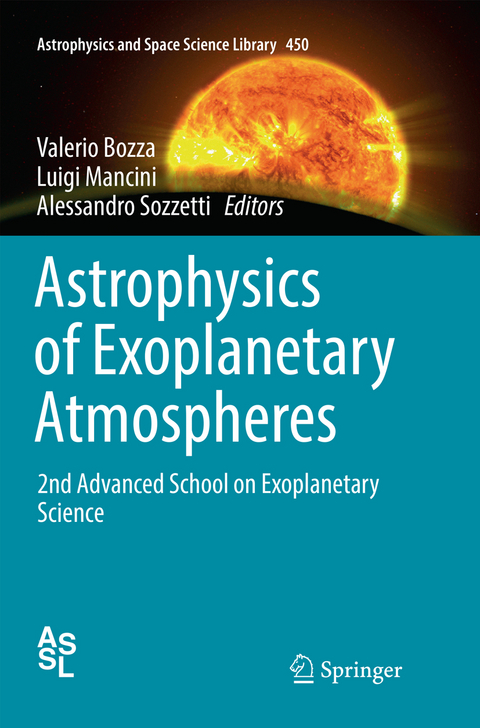
Astrophysics of Exoplanetary Atmospheres
Springer International Publishing (Verlag)
978-3-030-07836-2 (ISBN)
Valerio Bozza is a Staff Researcher in the Physics Department of Salerno University, Italy. He has worked at CERN with Gabriele Veneziano on string cosmology and cosmological perturbations, and become an expert of gravitational lensing by black holes, publishing several reviews. He has then developed the fastest publicly available code for modeling planetary microlensing events, which is at the basis of all major existing modeling platforms. He is a member of the WFIRST Microlensing Science Investigation Team, and member of several microlensing collaborations searching for extrasolar planets. His real-time modeling platform has become the standard reference in the community for driving follow-up observations. He is responsible for the Astronomical Observatory of the University and Salerno, performing microlensing observations and validation of transiting extrasolar planets. He is deeply involved in teaching and dissemination, hosting visitors and schools at the Observatory in monthly visits. Luigi Mancini recently became a research staff scientist in the Department of Physics, University of Rome Tor Vergata, Italy, having previously held the same role at the Max Planck Institute for Astronomy, Heidelberg, Germany. He studied Physics and Astrophysics at the University of Salerno, Italy, and then at the University of Zurich, Switzerland. In 2017 he gained Italian National Academic Qualification as a full professor. He is member of the executive board of the HAT-South Project and work on the detection and characterization of transiting exoplanets. In recent years he has been a collaborator of the JWST Early Release Science working group, and member of other collaborations. He is the author of more than 150 papers in peer-reviewed journals and acts as a reviewer for The Astrophysical Journal and other journals. His h-index is 32.
2nd Advanced School on Exoplanetary Science: Astrophysics of Exoplanetary Atmospheres.- Chapter 1: Modeling Exoplanetary Atmospheres, by Jonathan J. Fortney.- Chapter 2: Observational Techniques, by David Sing.- Chapter 3: Molecular spectroscopy for Exoplanets by Jonathan Tennyson.- Chapter 4: Solar system atmospheres by Davide Grassi.
| Erscheinungsdatum | 02.08.2019 |
|---|---|
| Reihe/Serie | Astrophysics and Space Science Library |
| Zusatzinfo | XV, 199 p. 95 illus., 55 illus. in color. |
| Verlagsort | Cham |
| Sprache | englisch |
| Maße | 155 x 235 mm |
| Gewicht | 456 g |
| Themenwelt | Naturwissenschaften ► Chemie ► Analytische Chemie |
| Naturwissenschaften ► Physik / Astronomie ► Astronomie / Astrophysik | |
| Schlagworte | Exoplanets advanced school • Formation of giant planets • High dispersion spectroscopy • Modeling exoplanetary atmospheres • molecular spectroscopy • Observational Techniques • planetary atmospheres |
| ISBN-10 | 3-030-07836-1 / 3030078361 |
| ISBN-13 | 978-3-030-07836-2 / 9783030078362 |
| Zustand | Neuware |
| Haben Sie eine Frage zum Produkt? |
aus dem Bereich


